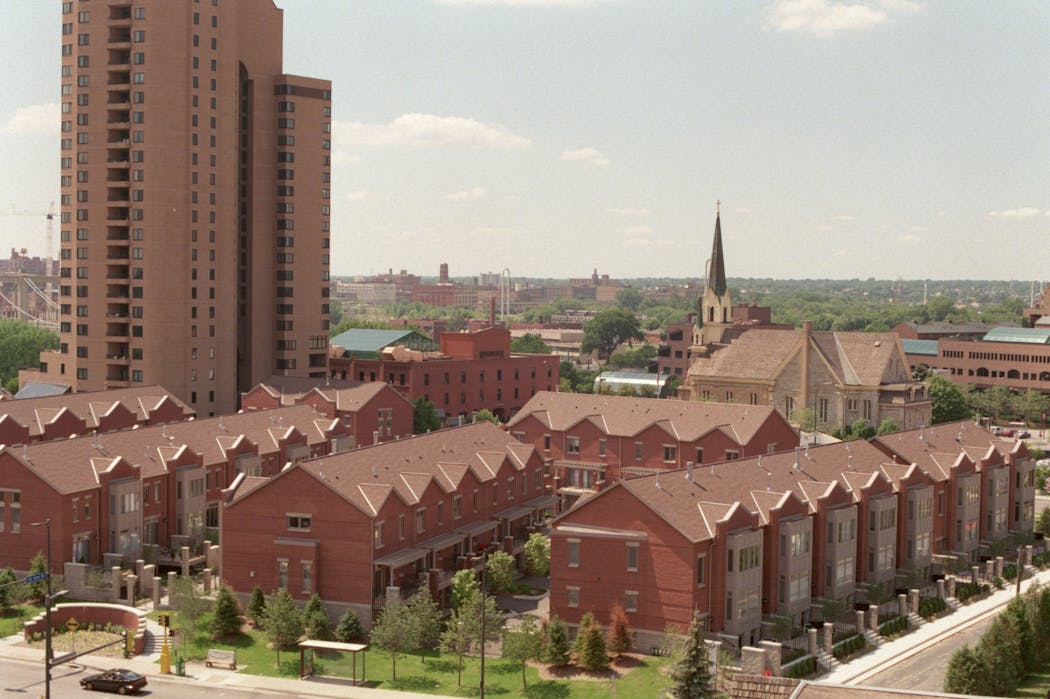In the 1940s, motorists crossing the 3rd Avenue Bridge from downtown Minneapolis were greeted by one of the most remarkable advertising signs ever created in the Twin Cities.
Mounted on the sides of a 240-foot tower, the short-lived sign touted Coca-Cola in a very big way.
It featured neon-lit, 54-foot bottles of the popular beverage beneath the word "Coca-Cola" in 16-foot script lettering. Like the classic Grain Belt Beer sign that now adorns Nicollet Island, the soda pop sign was hard to miss.
How the sign ended up where it did is a story that goes back to 1886, when Minneapolis civic leaders — eager to display the wonders of their burgeoning city — built an enormous hall called the Industrial Exposition Building along the west side of Central Avenue at SE. Main Street. Completed in a mere three months, the hall replaced another prominent building — the five-story Winslow House Hotel (1857), an imposing hunk of limestone that had offered guests fine views of St. Anthony Falls.
The exposition building hall served as the scene of annual expositions through 1890, when a Viennese tunesmith by the name of Johann Strauss waltzed in for an orchestral performance. Two years later, it hosted the Republican National Convention, which in true Minnesota fashion nominated a presidential candidate (Benjamin Harrison) who lost the election.
After the convention, the building received only sporadic use until 1903, when it was purchased by Marion Savage, an entrepreneur best known as the owner of the legendary pacer Dan Patch. Savage transformed the building into a warehouse for his stock-food company, equipping young clerks with roller skates to fill orders in the cavernous space.
By 1940, however, both Savage and his business were defunct, and the local Coca-Cola bottling company purchased the vacant structure, then tore most of it down with the intent of constructing a new plant on the site.
But those plans were soon shelved by the nation's entry into World War II. In the meantime, one portion of the Exposition Building — its lookout tower — still stood. The bottlers decided to turn it into a huge signboard for their product.
The sign was unveiled late in 1941, when the Minneapolis Tribune duly proclaimed it, perhaps with less than meticulous vetting, as "the largest sign in the world." While it may not have lived up to that moniker, it certainly must have been an eye-catcher. With the nation heading toward war, the old tower-turned-advertising-display also included public service signs urging the populace to "Buy Defense Bonds and Stamps."
At war's end in 1945, the bottling company moved forward with its plans. The new plant was built in two phases and appears to have been completed by 1948, when the Exposition Building tower and its signs finally came down.
The bottling plant turned out to be an interesting piece of architecture in its own right, an excellent industrial example of the Streamline Moderne style that enjoyed a brief period of popularity between about 1935 and 1950.
Designed by Mankato-based Ernest H. Schmidt and Co., the low-slung plant offered rounded corners and long bands of windows — two signature features of the Moderne style. Like the similarly styled Greyhound Bus Depot (now First Avenue) in downtown Minneapolis, the plant presented a sleek image of movement and modernity, drawn in part from the look of ocean liners.
An extant Coca-Cola bottling plant built in Los Angeles in 1939 took this nautical theme to its extreme. The building, which still stands, has portholes, catwalks and even a bridge from which the "captain" of bottling presumably commanded all hands on deck.
The Coca-Cola plant on Central Avenue wasn't the only one of its type in Minneapolis. Canada Dry, best known for its ginger ale, also built a Moderne bottling plant in 1946. Located at 3500 E. 28th St., it's now home to Hiawatha Academies.
As a child in the 1950s, I and my not entirely devout classmates at Ascension School toured the Coca-Cola plant in Minneapolis. I remember that the plant was noisy — bottles flying along the line at breakneck speed in what might be described as the ultimate sugar rush. Once the tour ended, I think we each received a small bottle of Coke as a prize. It truly was a marvelous time to be a schoolchild.
The plant remained in operation until 1981. By then, its prime location had made it a target for redevelopment as the city's riverfront renewal plans picked up steam. The Minneapolis Community Development Agency acquired the site in 1980, and the next year Coca-Cola Midwest, as the bottling company was then known, opened a new plant in Eagan.
The Central Avenue plant was demolished in 1982, and the site served as a parking lot until the Lourdes Square townhouses
Urban history is about, among many other things, how places can change in unexpected ways. So it is that this Central Avenue site has over the span of 164 years been home to a hotel, an exposition hall, a warehouse for animal feed, a towering sign, a bottling plant, a parking lot and now townhouses.
Whatever it becomes next will probably be a surprise.
Larry Millett is an architecture critic and author. He can be reached at larrymillett.com.

The 5 best things our food writers ate this week

A Minnesota field guide to snow shovels: Which one's best?

Summer Camp Guide: Find your best ones here

Lowertown St. Paul losing another restaurant as Dark Horse announces closing





